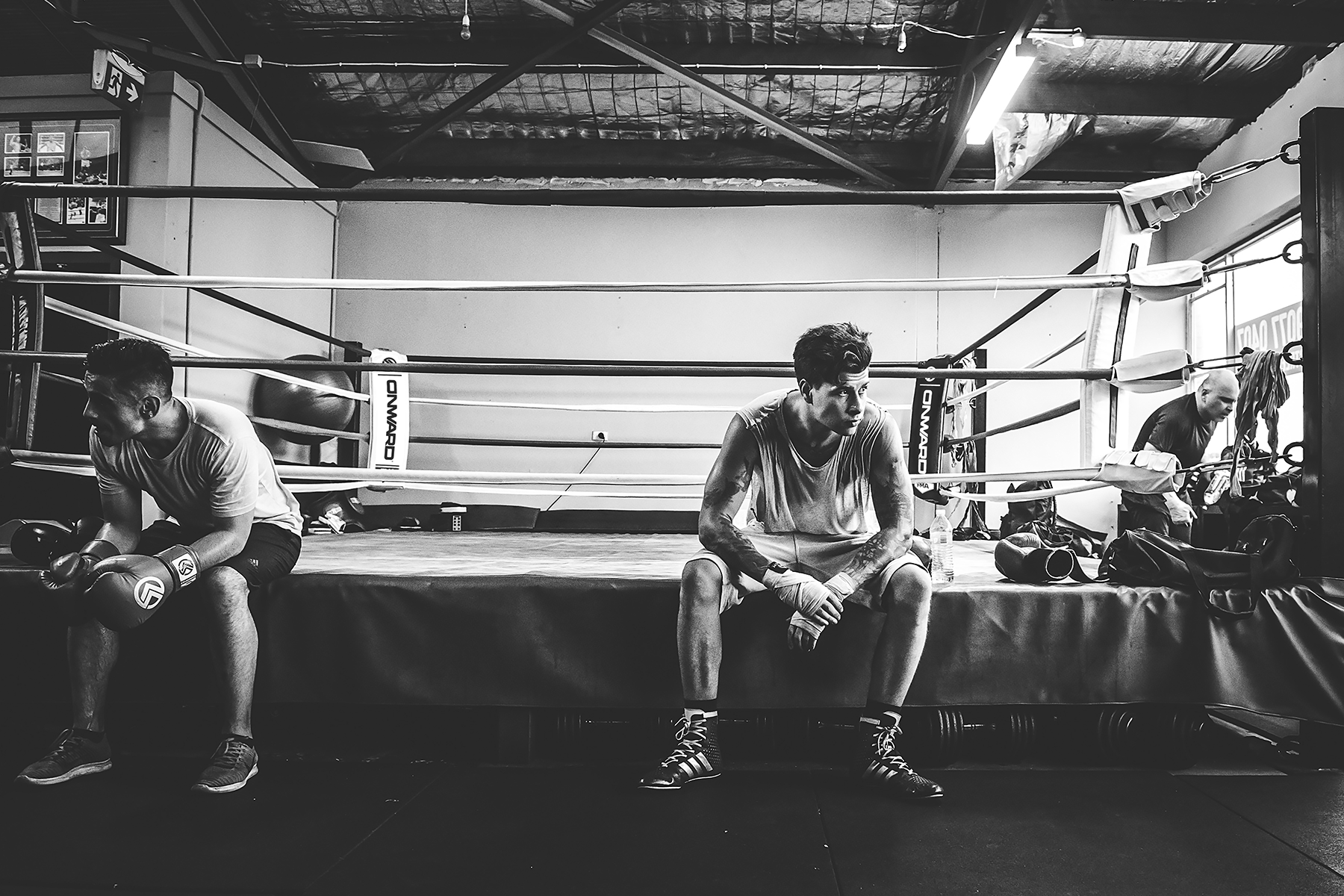CORNER TIME…The coach’s most important time of the fight
The Atmosphere
It's hot, it's loud, it's foreign territory, and if we don't turn this thing around, we've got a six-hour drive back staring at a cheap second-place medal. It’s evident by the way this first round is going that we’re in for scrap. We knowingly took a matched bout with a stronger, more experienced fighter who is slicker than I imagined him to be. All the adjustments running through my mind need to be prioritized so my boxer can digest the new game plan when he gets to the corner. I’m impatient for that moment to come as I can see he feels overwhelmed and is starting to resort back to the same bullshit I’ve been correcting for the last three months. Oh, and my assistant coach tells me that she somehow misplaced my corner towel (which I know she had on her shoulder walking to the ring).
The DJ’s trigger finger was so on point that the second the end-of-round bell rang, music is already blasting. And the MC is screaming on the mic battling with the DJ and security PA’s trying to keep the crowd hype. But the crowd was plenty engaged as we’re fighting in front of a hostile group of folks that have been cheering for the opposite corner since before we climbed in the ring. Side note: the corner stool they gave us is a 32-inch (81cm) gold plated bar stool…so my 17-year-old, 123lb (56Kg) athlete’s feet can hardly reach the canvas. The joys of amateur boxing I tell you! Shoot, even the bustling official's table near our corner, is loud and distracting, and the timekeeper keeps looking at us crazy. But never mind all that, I have a boxer to attend to, and I need to make the most out of these valuable seconds to help him get his hand raised after these next two rounds.
Preparation
As an amateur boxing coach, the entire process of preparing an athlete for a fight fulfills my soul in ways that nothing else can come close. Side note: a lot of people don’t like calling it that…most prefer calling a fight a “Bout." But let's be real, it's a FIGHT. It goes against all-natural human instincts to willingly put yourself in harm's way the way boxers do daily. It's a FIGHT, and like most competitive sports, when you have talent, heart, and have adequately prepared, you're likely to reap the benefits of all that hard work come time of the competition. The fight is the reward for the athlete after long training sessions, bloodshed over grueling sparring rounds, ignoring nagging injuries that resurface daily during roadwork, sacrificing their social life, and countless hours of sweating off unwanted pounds walking the dehydration tightrope leading up to the weigh-in.
When done correctly, training for a fight will test the hardest of combatants by forcing them in uncomfortable situations that will push an athlete to their limit. But few are cut out to do this day in and out without the target of a battle to test their fortitude. Safe to say most coaches (amateur or professional) will agree that without the end goal of an upcoming fight, it becomes more challenging to stay motivated.
The same way the athlete looks forward to the reward of a fight, as a coach, I look forward to those precious seconds between rounds during competition. Boxers, coaches, officials, and spectators alike will tell you that a particular connection happens between the athlete and coach while training. But that connection is not fully bonded until they have shared the ring in competition. It is only then that both parties will know whether or not everything the coach has been saying actually works, and the coach will know how the athlete performs under pressure. For those who haven’t had the experience of being eye-to-eye with a boxer between rounds, this should offer some insight into how awesome it truly is.
Pre-Fight
As the winning corner is announced from the prior bout, I like to position my athlete right at the first step and encourage them to bounce a little and make eye contact with the referee. This shows the ref that we are eager to get in the ring and makes a good impression as we wait to be invited through the ropes. After the athlete makes their rounds to salute the judges, timekeeper, and officials seated ringside, it’s usually just a few words of encouragement and a quick reminder of our first-round game plan. I believe the bond between coach and athlete is strengthened with every bout, and the more ritualistic the pre-bout experience is, the more comfortable the athlete enters the ring. So, I prefer a ritual of positioning and non-verbal communication before the first bell. I don’t like flooding the boxer with too many instructions at this point because there's usually a lot racing through their minds already, …especially for novice (inexperienced) athletes. By this time, the vast majority of the coaching has been done. Everything from this moment on moves into an IRT (In Real-Time) scenario.
Corner Time
As the round is nearing the end, I’m eager to get in the ring. Anxiously holding this ridiculous gold stool and inching towards the bottom step to jump in at the moment the round bell stops ringing to maximize every second with my athlete. As I step between the ropes, I always like to start with encouraging words while approaching the boxer and removing their mouthpiece. I do this regardless of the athlete’s body language. There have been times athletes are giving me the “I got this shit all day coach!” look…just as I have looked into the eyes of the defeated, seemingly saying, "can you get me out of here now?”. Regardless, I like to start with a few positive thoughts. Then, I spend a few seconds on general maintenance, ensuring that the athlete is breathing correctly, positioned right on the stool to allow for optimal circulation, and checking for any cuts or red areas that might need attention. A quick sip of water, and now it’s time to get specific with instruction. Being eye level with the seated athlete is essential as there are tons of distractions in the corner for the boxer who is already having to multitask; thinking about recovery, wondering how the judges scored that last round, listening to their stablemate screaming out words of encouragement, trying to swallow some water, put their mouthpiece back in, adjust their head guard and all while listening to their coach give them valuable instruction they will need to process in less than 15 seconds to make whatever adjustments in the upcoming round.
There is no time more valuable to the athlete than those 20-25 seconds of connection and coaching. This is the time to unite with the athlete in a compelling way that will directly enhance their performance in the coming round. Seated in their corner is their safe place where they can be vulnerable, open to criticism, and, in most cases, are looking only to their coach for guidance on how to perform better. It’s imperative you block out all of those distractions I mentioned earlier and focus on your boxer. As I'm advising on adjustments, it’s clear from the way the athlete responds that they are ready to make the necessary adjustments or not. The athlete must trust what the coach is instructing them to do will work. Many will argue that all the coaching is done by the time of the fight. There's some good truth to that, but every punch, every angle, every slip and block, knockdown, or standing eight-count is an opportunity to learn and grow, and those athletes who can adjust on the fly always seem to be a step ahead of the competition.
Coaches take some advice from a fellow coach that looks forward to the time between rounds the same way a high school senior looks forward to graduation day…Cherish that time!
Make the most of it with a calm demeanor, concise instruction, and positive reinforcement that will fuel their emotional tank. The process of preparing your athlete for battle can be physically, emotionally, and mentally draining, but this particular short period can revitalize both athlete and coach. So, take a minute to appreciate the moment. There are no other 60 seconds like it in all of the sports!





Leave a comment